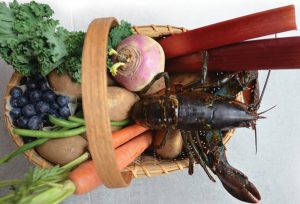Food for Thought
Undergraduate Michaela Murray found her academic path on the road to sustainability
UMaine ecology and environmental science major Michaela Murray had always been interested in doing student research but it wasn’t until the end of her sophomore year that she acted on that desire.
Hoping to begin a research project that summer, Murray—who is an Honors College student with a minor in economics— learned through the grapevine about a pilot project the Honors College was starting with funding from the Senator George J. Mitchell Center for Sustainability Solutions.

The Farm to Institution Food Project (F2I) turned out to be right up Murray’s alley, although she didn’t know that at the time. It wasn’t until another undergraduate research opportunity came up in the School of Economics—the Sustainable Ecological Aquaculture Network (SEANET)—that everything fell into place.
“I didn’t know this was a research interest of mine until I started doing both these projects dealing with sustainable food systems,” Murray says. “I’ve grown to really care about this topic and I hope to stick with it.”
What’s more, the F2I project was the first time Murray became aware of the Mitchell Center.
“I looked the Mitchell Center up on the web and thought, ‘This is incredible, UMaine has a whole center dedicated to sustainability solutions.’ And I was sad that I hadn’t been aware of it beforehand,” Murray recalls.
“I looked the Mitchell Center up on the web and thought, ‘This is incredible, UMaine has a whole center dedicated to sustainability solutions.” —Michaela Murray
Murray arrived at UMaine with a background in nutrition that became her first-year focus, but after just three weeks she realized that was not her cup of tea.
“So I switched to environmental science and immediately felt at home. I knew it was what I wanted to focus on because a lot of the coursework I was doing and people I was talking to centered around sustainability,” Murray says.
She adds, “Once you start learning about all the various aspects of sustainability it really starts clicking and you start to think, ‘This is it, this makes sense, this is what we all need to be working towards.’”
More specifically, she has found sustainable food issues to be particularly important and interesting to work on because, she asserts, “food is such a large part of every culture and making food systems sustainable is imperative.”
Her F2I work led to her participating in the Mitchell Center Sustainability Lightning Talks last November. Her talk, titled “Bringing Local Food To All: Challenges and Opportunities in Farm To Institution Initiatives,” outlined the common problems and advantages of F2I practices that she identified from an extensive literature review of over 40 peer-reviewed journals and data sources.
Farm to Institution
Across the nation, local food movements are gaining popularity as individuals and businesses alike begin to see the added value of sourcing and consuming locally produced food. One such mechanism for local food procurement are F2I initiatives, in which large-scale operations like K-12 schools, universities, hospitals, and corporations, work with small- to medium-sized farmers in their area to offer local products to their patrons.
Inevitably, notes Murray, there are both challenges and opportunities associated with forming and maintaining these relationships. “Understanding these is crucial for devising the most effective relationships between F2I stakeholders, and thus increasing the success of F2I programs in the nation’s changing foodscape.”
After doing her literature review, Murray used an analytical process to identify certain patterns regarding the challenges and opportunities common to F2I efforts. She outlined these in her Lightning Talk.
The top challenges Murray identified were price and costs, which can limit participation in F2I. Institutions are often constrained by tight budgets and don’t feel they can afford to purchase locally because farms usually charge higher prices than conventional distributors. That said, UMaine recently announced that it is now getting 23 percent of its food from local growers and producers and did so two years ahead of schedule.
Availability and scale were other issues that came out of Murray’s analysis. That is, Maine farmers are constrained by the growing season and “sometimes institutions feel like they won’t be able to have a year-round supply and that’s a disincentive to participate.” An additional impediment is “infrastructure concerns, like not having the right transportation or storage facilities available,” Murray says.
Despite these challenges, there were also identifiable opportunities, with the utmost being relationships, according to Murray.
Often the relationships between supply chain actors and F2I markets “are a little bit more close-knit than conventional food systems so there tends to be a higher sense of trust and communication in these sorts of markets, which can help increase the value of the food product and create a willingness to negotiate between the supply chain actors.”
Additional opportunities Murray identified include the social benefits, improved nutrition that comes with having more universal access to healthier food that local farmers can provide, and environmental benefits like reduced food mileage and fuel usage.
So how might all this be helpful to future F2I initiatives?
“This work has helped to identify some of the gaps in the literature, which has directly inspired some of the Maine stakeholder interviews that my research colleagues conducted recently,” Murray says. “We hope that the results of the interviews and this work I did over the summer will influence future plans of action to help strengthen F2I research networks and facilitate stakeholder partnerships in Maine.”
“Once you start learning about all the various aspects of sustainability it really starts clicking and you start to think, ‘This is it, this makes sense, this is what we all need to be working towards.’” —Michaela Murray
“Michaela has been an integral part of our grant team and her work was invaluable as we considered pilot interviews of F2I supply chain actors,” says F2I team member Stephanie Welcomer, Professor of Management, UMaine School of Business.
Murray, Welcomer adds, helped the team develop more useful interview questions and provided a systemic framework they could draw from. “Using her analysis we were able to ask questions that moved the conversation forward. I think the respondents were able to engage with us in a way that linked past practices and challenges to new ways of solving problems and stories of success,” Welcomer says.
Murray notes that the most recent work, including information gathered from the Maine stakeholder interviews recently conducted by Farm to Institution team co-leader Mark Haggerty, Rezendes Preceptor for Civic Engagement in the Honors College, and Welcomer, will be part of upcoming Mitchell Center Sustainability Talk February 5 titled “The Puzzle of Making the Local Food Movement Sustainable: The Challenge of the Supply Side Chain. Team members will also be outlining their recent work at the Maine Farm to Institution Summit 2018 in Belfast, Maine on February 9.
—David Sims
